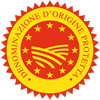Description
The San Simón da Costa PDO is a semi-fat cheese produced from raw or pasteurised, natural and whole milk, coming from cows of the breeds Rubia Gallega, Bruna Alpina, Frisona or their crossbreeds.
Production Area
The production area of the San Simón da Costa PDO is within some municipal areas of the Lugo province, in the Autonomous Community of Galicia.
Production Method
The processing starts with the curdling of the milk within 48 hours of the milking. The curdling takes place for 30-40 minutes at a temperature of 31-33°C, or 28-32°C if raw milk is used. After the break of curd, the paste is placed in moulds with adequate shapes and sizes. Then follows the pressing in moulds wrapped up in cotton cloths to facilitate whey elimination and the smoothing of the rind. Successively, the salting procedure in brine for 24 hours is executed. The ripening extends for at least 45 days for the big format, and 30 days for the small; during this period the cheeses are regularly cleaned and turned. An optional practice is the immersion of the cheeses in an anti-mould bath made with olive oil or another authorized product. Finally, the cheeses are smoked for the time necessary to lend it its characteristic colour.
Appearance and Flavour
TSan Simón da Costa PDO has an intermediate shape between a ball and a top shell, with a pointy upper part. The big format can weigh from 0.8 to 1.5 kg, while the small one weighs between 0.4 to 0.8 kg. The rind has an ochre yellow colour typical of the smoking, and is hard and considerably fat. The paste has a colour ranging from white to yellow, and is semi-hard but soft to the cut, while its aroma and flavour are very characteristic. The holing is more or less scarce, with irregular rounded shapes and variable sizes.
History
Regarding the origins of the San Simón da Costa PDO, legend has it that this cheese was invented by populations of the castreña civilization, probably descendants of the Celtic tribes. According further to the tradition, during the Roman period the cheese was sent to Rome, where its characteristic flavour and its good preservation were appreciated. Later, the San Simón was also used as payment currency for tributes and tithes to the feudal lords and the Church.
Gastronomy
The San Simón da Costa PDO is best preserved in the refrigerator, wrapped up in Clingfilm to avoid the loss of fat, which causes the paste to dry up. It is recommended to remove it from the refrigerator at least 30 minutes prior to serving. It is excellent as appetizer or as ingredient in salads, it is also very tasty as desert. It is furthermore used to fill stuffed foods or as ingredient in sauces. It is perfect with new red wines.
Marketing
The product is sold as San Simón da Costa PDO. It is marketed in whole pieces and possibly portioned, subject to the control body authorization.
Distinctive Features
The production area of the San Simón da Costa PDO is characterised by a temperate and humid climate, which favours the growth of abundant first-rate pasture grass. This kind of nutrition lends the milk used its unique characteristics, which, combined with the old tradition of small family-run productive companies, make this cheese a product with a singular flavour and excellent quality.






